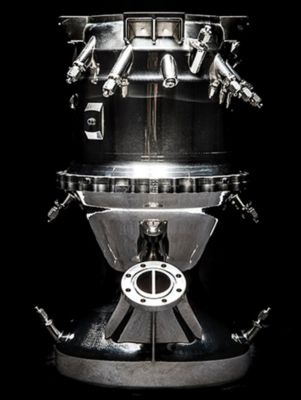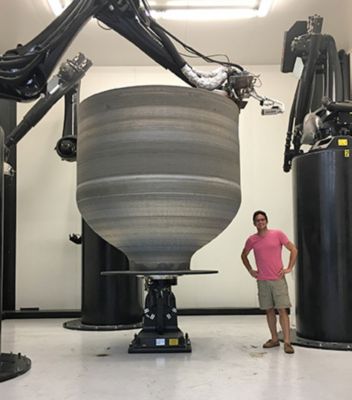-
United States -
United Kingdom -
India -
France -
Deutschland -
Italia -
日本 -
대한민국 -
中国 -
台灣
-
앤시스는 학생들에게 시뮬레이션 엔지니어링 소프트웨어를 무료로 제공함으로써 오늘날의 학생들의 성장을 지속적으로 지원하고 있습니다.
-
앤시스는 학생들에게 시뮬레이션 엔지니어링 소프트웨어를 무료로 제공함으로써 오늘날의 학생들의 성장을 지속적으로 지원하고 있습니다.
-
앤시스는 학생들에게 시뮬레이션 엔지니어링 소프트웨어를 무료로 제공함으로써 오늘날의 학생들의 성장을 지속적으로 지원하고 있습니다.
ANSYS ADVANTAGE MAGAZINE
DATE: 2018
Breaking the Mold
By Ansys Staff
Relativity Space was founded in 2015 with a unique vision: to leverage additive manufacturing technology to 3D-print rockets that can be launched into space. This ambitious California-based startup is poised to change the global aerospace industry by making rockets exponentially faster, cheaper and simpler to produce. Already on its way to rewriting the rules for commercial satellite launches, Relativity hopes to eventually manufacture its 3D-printed rockets on Mars — where this innovative, affordable technology could be used to support human colonization.
"There is no way other than simulation to get that level of fidelity and confidence when you’re managing an additive manufacturing run."
Relativity Space aims to be the first company to launch a rocket produced entirely via 3D printing, or additive manufacturing. The company’s Aeon rocket engine includes just 100 parts and is produced in three print runs.
When they met as undergraduates at the University of Southern California, Tim Ellis and Jordan Noone bonded instantly over their shared love of rockets. They worked together in USC’s Rocket Propulsion Lab, formed by a group of students who wanted to be the first undergrads to send a rocket into space.
After graduation, Noone went to work for SpaceX and Ellis was hired by Blue Origin. The two reconnected in 2015 and decided to launch a startup called Relativity Space. Their new company was based on a novel concept: producing rockets via emerging 3D printing technology, also known as additive manufacturing (AM). While other aerospace companies were printing vehicle components, Ellis and Noone wanted to be the first to produce an entire rocket via AM technology.
The founders recognized that there are many advantages to additive manufacturing. The structure can be simplified. A rocket made of 100 parts using AM is going to be much more structurally stable and inherently stronger than one composed of 10,000 separate components. AM significantly streamlines assembly, and makes the end-to-end supply chain much simpler and more seamless. AM also removes restrictions on novel geometry and opens up design options.
"When we said we wanted to 3D-print rockets, a lot of people thought we were crazy," says Noone, the company’s chief technology officer. “But people with experience in the industry saw the potential in our idea.” One of those people was billionaire investor Mark Cuban, who committed $500,000 in funding to get Relativity off the ground. Relativity was also accepted into the prestigious Y Combinator program, which offers funding and strategic consulting to entrepreneurial companies.
Backed with capital and a business plan, there was only one major issue: Ellis and Noone could not find a 3D printer big enough to produce a rocket. So the pair did what any visionary would do. They built their own printer.
STARGATE: LAUNCHING A NEW GENERATION OF AM
Nine feet in diameter and 15 feet tall, the resulting machine — called Stargate — resides at the company’s headquarters in Los Angeles, California, and is the world’s largest 3D printer.
The complex process of engineering the Stargate printer was managed in part via simulation. Both Noone and Ellis had used Ansys software at their previous jobs, and they contacted Ansys within eight days of founding Relativity Space. “Ansys software is very well regarded in the global aerospace industry,” notes Noone. “It’s a trusted technology, known to be extremely accurate as well as easy to use. We knew we needed Ansys to bring our ideas to life.”
Relativity was able to quickly access software licensing through the Ansys Startup Program. “Partnering with Ansys early on was critical in accelerating the design cycle for Stargate, as well as making sure we got the physics right,” says Noone. “For example, we simulated the computational fluid dynamics inside the printer to optimize material flows during the actual printing process.”
While designing and building the printer took time and money, the investment was significantly lower than the tens of millions of dollars required to buy fixed tooling and build a manufacturing plant.
Using a 3D printer also maximizes the engineering team’s flexibility as it iterates on product designs. “It might take months, and millions of dollars, to retool a traditional manufacturing facility,” Noone points out. “But we can achieve a new engine design in 18 days, and a completely new vehicle iteration in 30 days. That gives us unmatched agility and responsiveness in the aerospace industry.”
"When we said we wanted to 3D-print rockets, a lot of people thought we were crazy."

"We knew we needed Ansys to bring our ideas to life."
AEON: THE FIRST 3D-PRINTED ROCKET ENGINE
Engineers at Relativity also relied on simulation via Ansys to design Aeon, the first rocket engine produced solely with additive manufacturing technology. Capable of producing 15,500 pounds of thrust at liftoff, Aeon is composed of a nickel alloy. With only three parts, the engine is manufactured in three separate print runs.
The Relativity product development team leveraged Ansys Fluent software to conduct computational fluid dynamics (CFD) simulations of the engine’s injection element, cooling holes and manifold. By optimizing flows in these areas, engineers were able to reduce the overall design cycle and the high costs of physical testing.
The company’s engineers also used Ansys Mechanical to assess structural stresses inside the Aeon engine during important events such as liftoff. More than 100 test fires have confirmed that the Ansys simulations effectively optimized Aeon’s strength and structural stability.
Relativity’s Stargate is the world’s largest 3D printer.
OPTIMIZING RESULTS VIA ANSYS ADDITIVE SUITE
As a producer of some of the largest 3D-printed objects in the world, Relativity Space was naturally interested when Ansys introduced Ansys Additive Suite in 2018. In fact, Relativity was the first official customer for this new family of software that optimizes the 3D printing process, from materials composition to machine settings.
“We are thrilled with Ansys Additive Suite,” says Noone. “By simulating the results of each print run — before we actually commit materials and machine time — we are substantially lowering our risk exposure.”
Noone notes that producing huge part shapes from metal materials means a very high cost of trial and error. The new capabilities in Ansys Additive Suite enable the Relativity engineering team to predict and address areas of deformation, ensure geometric accuracy, eliminate material waste and avoid potential machine damage — among other benefits. Says Noone, “There is no other way to get that level of fidelity and confidence when you’re managing an additive manufacturing run.”
NEXT STOP? MARS
The initial application for Relativity’s Aeon engine and its launch vehicle — called Terran — will be in the commercial satellite market. The company occupies a unique niche in this industry, offering pay-per-launch services for satellites in the 1250-kilogram range, or about the size of a small car.
With its capability to manufacture a new launch vehicle every 60 days via AM technology, compared to one year of development time using traditional manufacturing methods, Relativity hopes to dominate this fast-growing market segment. It is already signing up customers for its first launch, scheduled for 2020.
But Relativity Space’s long-term vision reaches much farther. This energetic startup hopes to be the first company to produce and launch 3D-printed rockets on Mars.
“We envision human colonies thriving on both Earth and Mars,” predicts Noone. “However, there will initially be very scarce resources on Mars. The flexible, relatively lightweight nature of AM technology will provide a fast, affordable means to build what humans will need to survive — and manufacture rockets to get back to Earth. Everything we have done in terms of engineering is focused on that end goal. For example, the Aeon engine is powered by oxygen and methane, two propellants that will be very easy to produce on Mars.”
“We recognize that this vision sounds ambitious, but we hope to inspire other startups to join in the effort to make humanity multi-planetary. Just because your company is small doesn’t mean you can’t dream big,” concludes Noone.
당신을 위한 Ansys 솔루션을 알아보십시오.
당신을 위한 Ansys 솔루션을 알아보십시오.
문의하기
문의해 주셔서 감사합니다!
여러분의 질문에 답변해 드리기 위해 최선을 다하겠습니다. Ansys 담당 엽업이 곧 연락을 드릴 것입니다.














